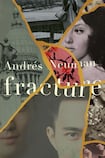
In Andrés Neuman’s latest novel, we meet Yoshie Watanabe, a retired electronics executive, in a Tokyo subway station one afternoon when he feels a vibration, then a tremor, before “the floor cease [s] to be a floor”. What he’s experiencing is the magnitude 9 earthquake that triggered the 2011 tsunami – the costliest natural disaster in history – and the meltdown of nuclear reactors in the Fukushima Daiichi nuclear power plant.
“An earthquake fractures the present, shatters perspective, shifts memory plates,” writes Neuman.
On the surface, Yoshie is a lucky man. Visiting Hiroshima with his father in August of 1945, he survived the devastation of the atomic blast simply by virtue of wearing white clothes and standing against a yellow wall (lighter colours, he would learn, absorb less energy). He then missed his scheduled train home to Nagasaki, narrowly escaping the second target of the Allied attack.
Yoshie doesn’t like to talk about the war and refuses to identify as a survivor, feeling it’s undeserved as his injuries were relatively minor. But the tragedy, including the loss of his parents and sisters, reverberates throughout his life.
The book is narrated in the close third person, alternating with the recollections of Yoshie's ex-girlfriends, as recounted to an Argentinian journalist who has become interested in his life story
Against official orders to avoid the area around Fukushima, Yoshie is compelled to drive into the belly of the beast to examine the fallout first-hand. He pretends to be a journalist to gain access. Interacting with the locals who have remained in the evacuation zone, he reflects on the odd symmetry between the aftermath of the atomic bombings and the nuclear accident.
His first impression of the coastal village is “the overwhelming sum of its silence. A very specific silence that Yoshie recalls having heard only once before in his life. There are peaceful silences that are a cure for noise, and others that emphasize absence”. He had never been able to convey what he saw in Hiroshima –“not for a lack of words, but rather of meaning”.
Unrest is everywhere
The book is narrated in the close third person, alternating with the recollections of Yoshie’s ex-girlfriends, as recounted to an Argentinian journalist who has become interested in his life story.
Violet, who met Yoshie when they were studying in Paris, recounts their relationship on the backdrop of the student protests of 1968 and unrest in Algeria. Lorrie, a journalist in New York, where Yoshie moved for a promotion, describes anti-Vietnam War activism and Watergate. Mariela, an interpreter in Buenos Aires, remembers their life there under a dictatorship and hyperinflation. Yoshie’s “autumnal” romance, with Carmen, a physiotherapist in Madrid, ends when he decides to return to Tokyo after the Atocha station bombings in 2004.
In short, unrest is everywhere, and Yoshie, too, is restless. (Contemplating an idea of Chekhov’s, he wonders if “our interest in new places lies less in our getting to know them than in escaping from a previous somewhere.”)
It’s an interesting idea to paint a portrait of Yoshie through the eyes of past lovers, like drawing negative space. And Neuman has masterfully embodied multiple narrators before: in Talking to Ourselves (2014), a dying man, his wife, and their 10-year-old son narrate in turns, in vibrant and varied voices.
In Fracture, however, the story as told at a remove by his lovers is less engaging than the scenes in which Yoshie is observing the destruction of Hiroshima and Fukushima first-hand. Yoshie’s back story is derailed by details of their own lives, and the women’s cadences converge.
Japanese art of repairing
Born in Argentina, Neuman moved to Andalusia as a teenager. Anointed by Roberto Bolaño and a darling of the Spanish literary scene, he has written more than 20 books in his native tongue, including poetry and aphorisms. Having come to the attention of the English-speaking world with the widely-acclaimed Traveller of the Century (2012), Fracture, translated by Nick Caistor and Lorenza Garcia, is the fifth of Neuman’s books to appear in English.
If a Japanese disaster seems an unlikely topic for Neuman, he was struck, he has said, at how most human cultures “seem equally capable of both powerfully rebuilding and self-destructing”.
As news spreads about the reach of the disaster, Yoshie is amazed to read that “the previous day’s earthquake may have moved the whole country by a couple of meters, and shifted the earth’s axis by ten or fifteen centimetres. Nothing occurs in only one place, he reflects, everything occurs everywhere.” The global reverberations of catastrophe - from Alaska to Sumatra - feel all too pertinent amid our present pandemic. (In a prescient detail, after the earthquake, Yoshie finds the Tokyo supermarket shelves empty of toilet paper and diapers.)
Yoshie is an admirer of kintsugi, the Japanese art of repairing fractured pottery with powdered gold, honouring its imperfections. More idiosyncratically, perhaps, he collects battered banjos, moving them with him from city to city. Yoshie tries to instil a sense of order in his life by tuning the banjos in turn. After the earthquake, he finds his instruments in disarray.
“None appears to have suffered irreparable damage. But then, he corrects himself, to what extent is damage reparable?”










